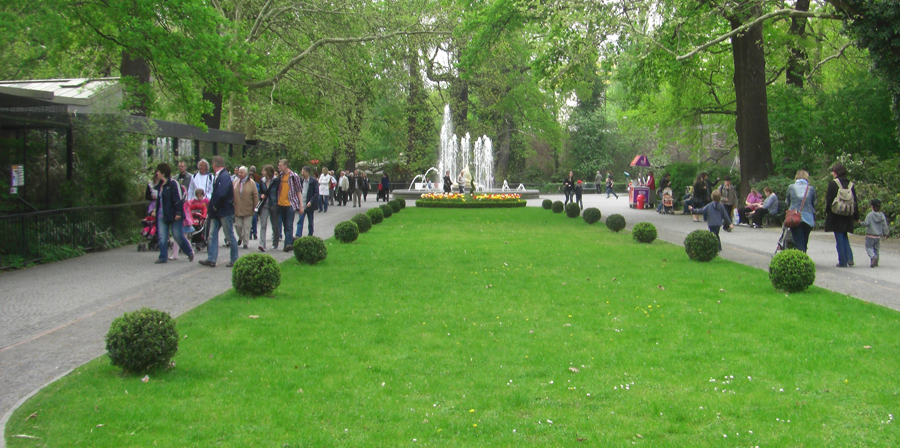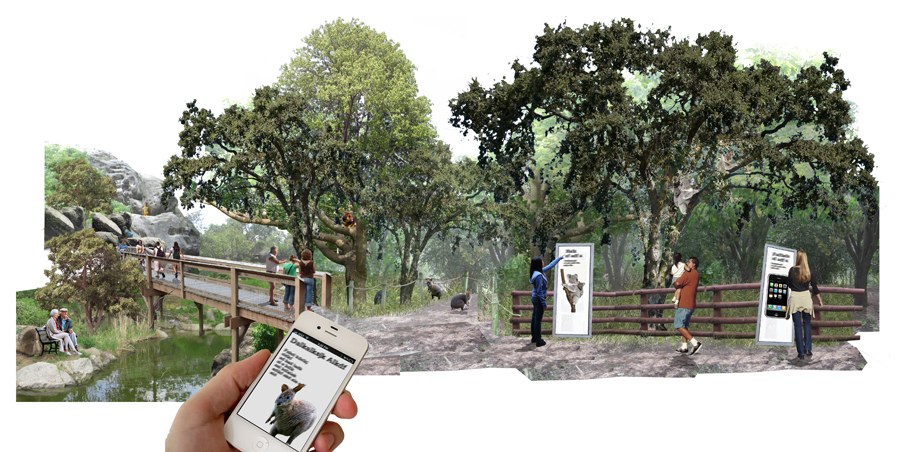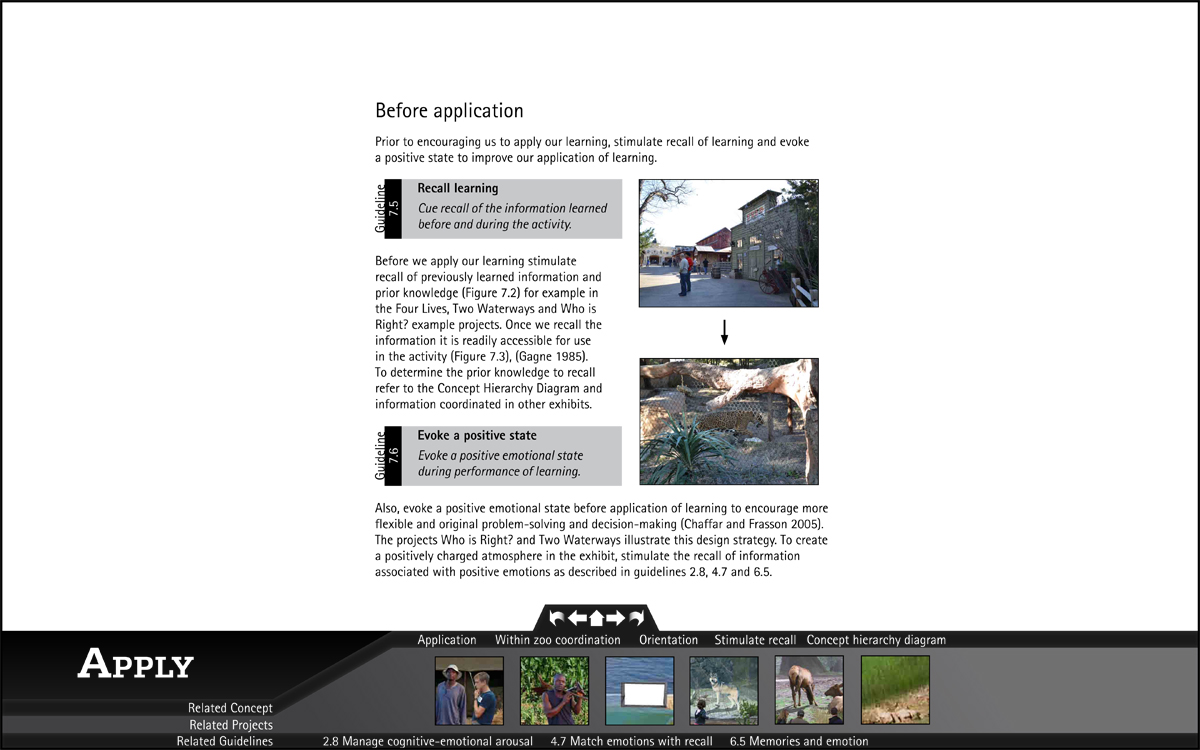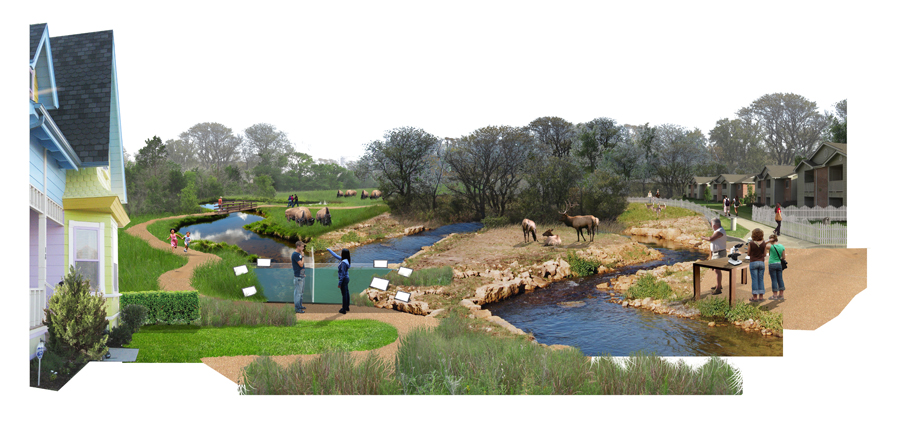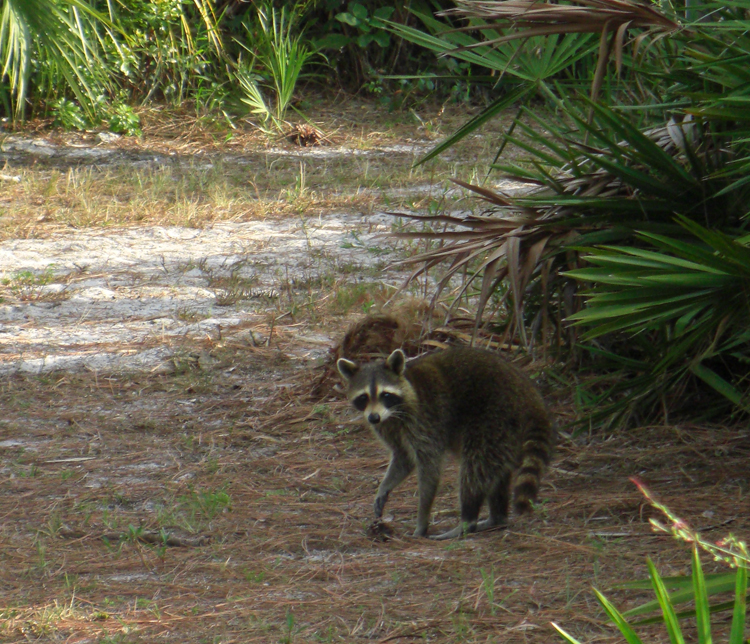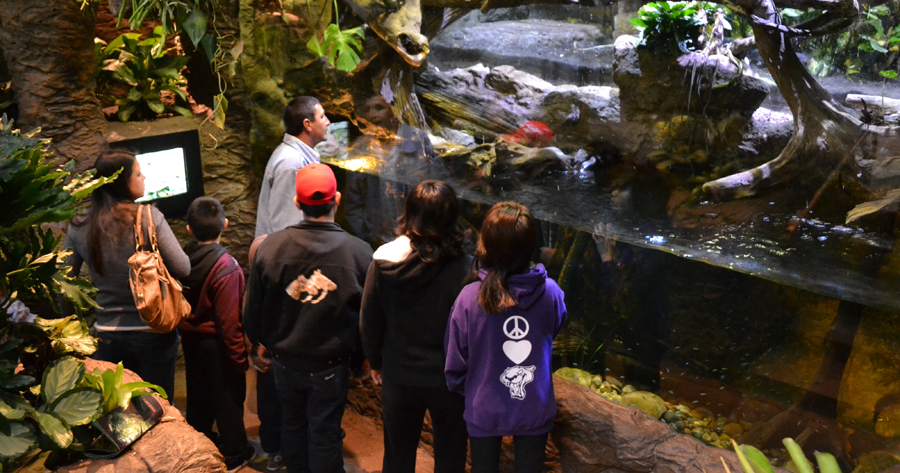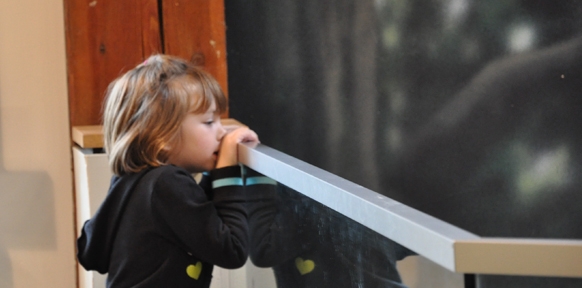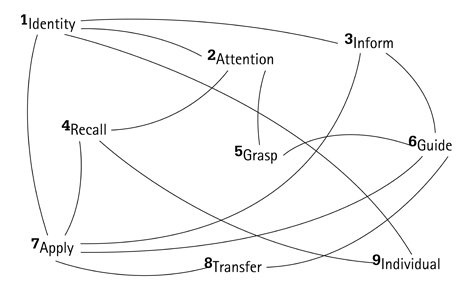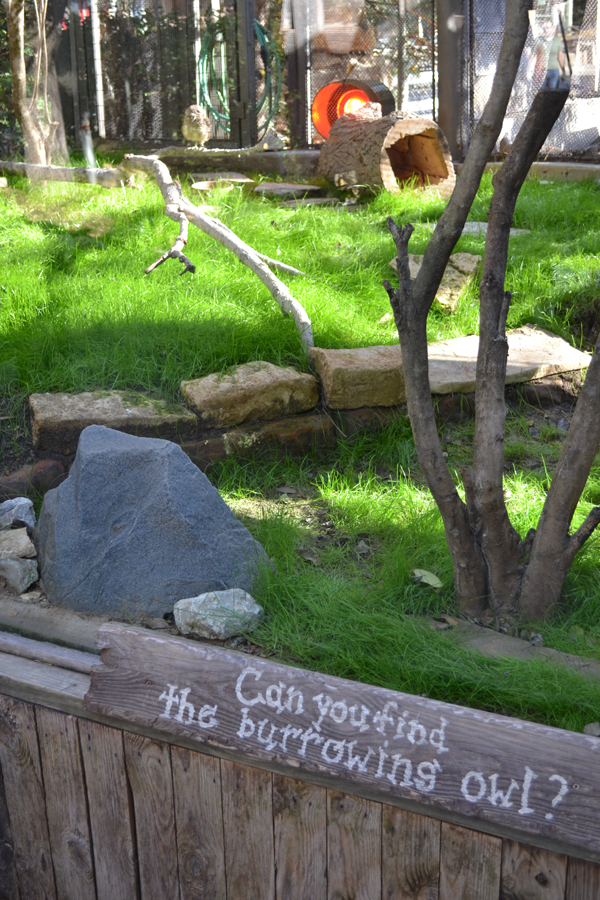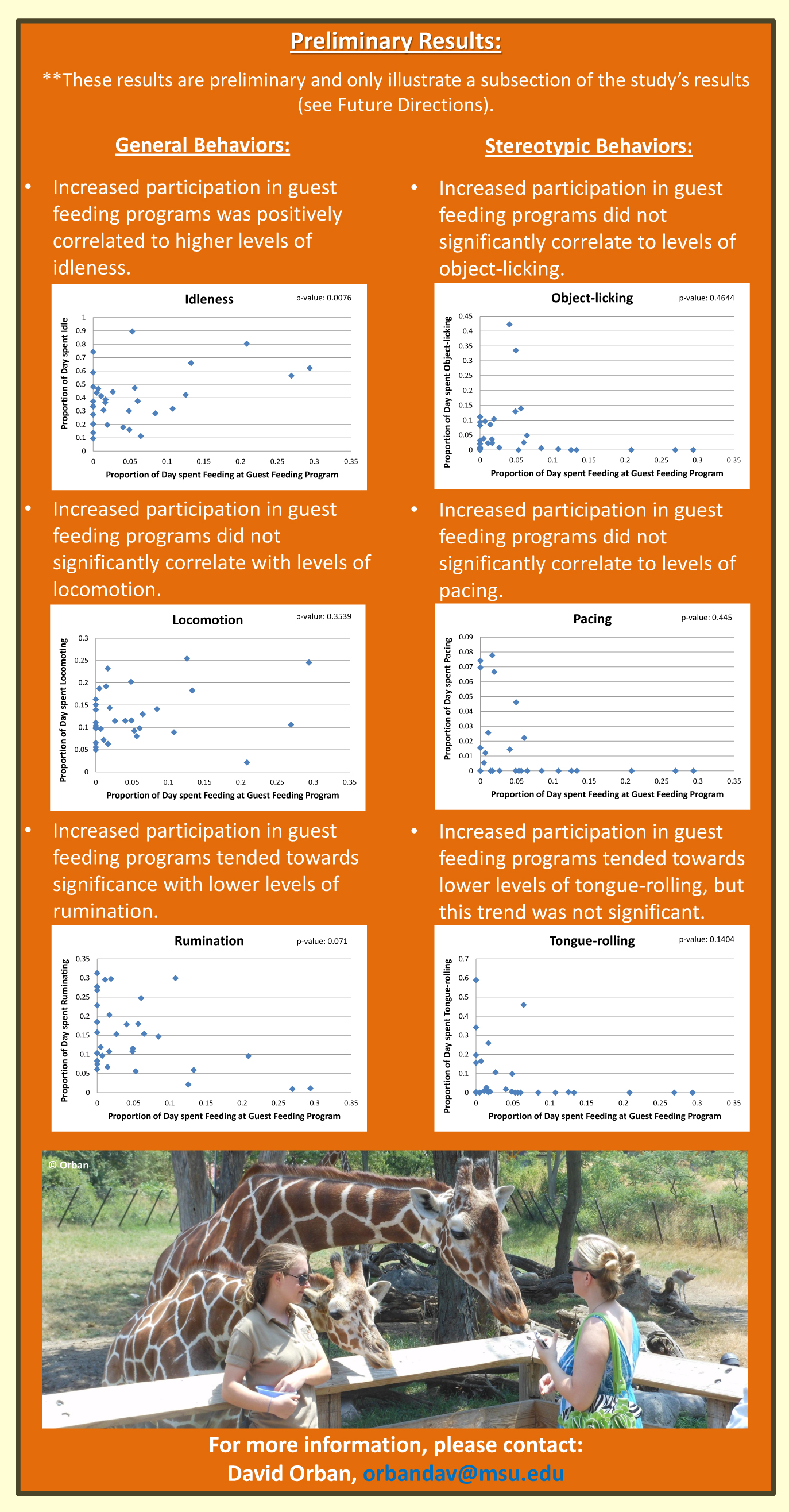Recently, I was invited to guest-blog over at Blooloop.com's site, Bemusement. Blooloop caters to the attractions industry as a whole, but is committed to increasing coverage of zoos and aquariums. Because many of Bemusement's readers are unfamiliar with the vast challenges facing zoos on a day-to-day basis, I wanted my first post to serve as a backgrounder on zoos while also addressing an interesting and timely topic, de-extinction. By examining de-extinction in the context of zoos, I found some interesting and unexpected corollaries between the two related, yet often ethically controversial, topics. Read my post at Bemusement here, and stay tuned for my monthly contributions.
Designing for Lemur Conservation
In follow up to my visit to the Lemur Conservation Foundation, a final year landscape architecture student has dedicated his senior capstone to the future planning of the facility. Take a look at his work here: Conservation Is Our Middle Name: Meet Jabari Taylor.
Spring Giveaway!
UPDATE 5/13: Congratulations Milo! Springtime brings the colorful resurgence of warmth and the happy reminder that summer is just around the corner! Springtime also brings smiles and sleepy bears emerging from their winter slumber. Appropriately, the DesigningZoos.com spring giveaway is a signed copy of Else Poulsen's "Smiling Bears: A Zookeeper Explores the Behaviour and Emotional Life of Bears."
 I met Else at the Bear Care Group's Advancing Bear Care Conference in 2011 where she shared her incredible wealth of captive bear knowledge. She holds a bachelor’s degree in biological sciences, and has worked at the Calgary and Detroit zoos. She is known internationally for her captive bear husbandry and rehabilitation. In 2000 she won the Zookeeper Research Excellence Award from the American Zoo and Aquarium Association’s Bear Taxon Advisory Group. She works as an animal management consultant for zoos, sanctuaries, wildlife rehabilitators, and other animal welfare groups and lives in southern Ontario.
I met Else at the Bear Care Group's Advancing Bear Care Conference in 2011 where she shared her incredible wealth of captive bear knowledge. She holds a bachelor’s degree in biological sciences, and has worked at the Calgary and Detroit zoos. She is known internationally for her captive bear husbandry and rehabilitation. In 2000 she won the Zookeeper Research Excellence Award from the American Zoo and Aquarium Association’s Bear Taxon Advisory Group. She works as an animal management consultant for zoos, sanctuaries, wildlife rehabilitators, and other animal welfare groups and lives in southern Ontario.
Enter the giveaway by telling me about your favorite bear exhibit in the comments section below. A winner will be chosen at random on May 12.
Interactivity and Zoos
A recent article by Wayne LaBar, the founder and principal at Alchemy Studios, outlined some of the growing trends in interactivity in museums...and got me to thinking: Are these also trends we are seeing in zoos and aquariums? If not, should they be? Certainly, interactivity in experience and educational opportunities are important aspects of zoo design. However, our industry may not lead the charge due to the simple fact that zoo visitors come to see animals primarily. Interactivity adds to the experience, elevates the excitement, and could serve as an educational platform, but in the end, guests would be happy just getting to see animals. Museums face a more difficult challenge in communicating often abstract concepts to their visitors without the benefit of a cute furry face, and thus seem to be the driving force of innovation on interactivity and interpretation in general.
Let's take a look at the current trends.
Certainly one of the largest movements occurring in children’s museums and science centers is the creation of Tinkering or Making spaces. This is a movement that originates from the work done by Make magazine and their affiliated “Maker Faires.” (www.makerfaire.com) As museums witnessed the creativity and the direct interaction that the public has with STEM (science, technology engineering and math) content, an essential need for museums to attract audience and funding, Tinkering/Maker spaces are popping up in many places. A Tinkering space is a place where visitors are allowed to build, create and tinker with low-end technology, use real tools and explore the concept of making something. These are usually staffed spaces although some are trying to explore minimizing staff engagement. Often, special events, fairs and other programs are being held in connection with these spaces. A key aspect of this is that these spaces do not require extensive design and development schedules and costs. They are a marriage of exhibit and program, where the activity is more important than the environment. The Exploratorium with their Tinkering Studio (blogs.exploratorium.edu/tinkering/) , New York Hall of Science who hosts the NYC Maker Faire and issued a report (www.nysci.org/learn/research/maker_faire_workshop) , and the Pittsburgh Children’s Museum MAKESHOP (pittsburghkids.org/exhibits/makeshop) are some of the leaders in this endeavor.
This one is somewhat limited in zoos and aquariums. I've heard about learning to basketweave or make jewelry and enrichment days where guests can make items for the animals (discussed further below), but generally the act of 'making' isn't the first thing that comes to mind when discussing the animal world. However, it is an interesting topic in that part of our challenge in zoo design is to create empathy. Many animals are, in fact, 'makers.' Birds build all sorts of nests in a variety of sizes, shapes and materials. Beavers make elaborate dams. Primates make and use tools. Even fish make nests! Why not create stations where these things can be experienced and explored in zoos?
Collaborative Exhibits & Events
In the constant search for innovative (yet budget-conscious) exhibits and interactivity, museums are increasingly looking to create ways in which people can interact by engaging with artists, groups and community organizations. Exhibitions based on this approach tend to have interactivity that may be more experimental or short-term, perhaps built around a weekend event or happening. A benefit of this type of low-impact interactivity is the opportunity to try things that are different and not necessarily built to the fabrication and durability standards that would define more traditional exhibits. Additionally, by reflecting engagement with community groups and other organizations, the exhibit becomes more social, and the social networks of these organizations, both physical and electronic, become engaged with the exhibits and potentially become part of the exhibitions themselves. One place exploring this direction is the Santa Cruz Museum of Art and History. Check out their event at (www.santacruzmah.org/events/) and read Nina Simon’s article in the latest NAME Exhibitionist issue.
The growing trend of Enrichment Days are what comes to mind in relation to collaborative events. Guests are encouraged to create and facilitate enrichment throughout the zoo, and in doing so, interact with keepers, docents and animals at a level not experienced on a normal trip to the zoo. I'm very curious about the effect of these special days as they exist now on visitor experience and how we can build from the basic idea to expand in a more socially engaging way as indicated by LaBar. Other events such as the now commonplace food / beer / music fundraising festivals (oftentimes called Zoofari) linger on the edge of being a collaborative event, but lack an integrated conservation / education message that could be leveraged during these gatherings.
New Interfaces
Certainly, an area that piques everyone’s interest in the interactivity field is devising new ways for people to engage with digital content or digital displays through more physical interfaces. We have seen a move away from the idea of keyboard-and-mouse to touchscreen to touch tables and now Kinect or Kinect-like interfaces. This outlines an evolution of the interface becoming more and more physical, more fully-body engaging and with more seamless physical/virtual experience. Over the past year, we have seen interest in new and innovative ways to engage people physically but also marrying that with digital content. Examples include the “Firewall” by Aaron Sherwood created in collaboration with Michael Allison, “Water Light Graffiti” done under the Digitalarti Artlab by the artist Antonin Fourneau, or the work done by ART+COM. In part, this is driven by the need for museums to provide experiences that cannot be duplicated at home. The interface advances also reflect the evolution of museum experiences moving into the home. These marriages of art, computer, physical world and content create interactivity and experiences that can’t be duplicated on your Xbox.
more fully-body engaging and with more seamless physical/virtual experience. Over the past year, we have seen interest in new and innovative ways to engage people physically but also marrying that with digital content. Examples include the “Firewall” by Aaron Sherwood created in collaboration with Michael Allison, “Water Light Graffiti” done under the Digitalarti Artlab by the artist Antonin Fourneau, or the work done by ART+COM. In part, this is driven by the need for museums to provide experiences that cannot be duplicated at home. The interface advances also reflect the evolution of museum experiences moving into the home. These marriages of art, computer, physical world and content create interactivity and experiences that can’t be duplicated on your Xbox.
 Interfaces are all over the map in zoos and aquariums. Partially due to the lack of budget and partially due to durability issues, zoos and aquariums vary in their usage of technology. Aquariums, with their somewhat controlled indoor environment, seem to be much more willing to embrace such things as touchscreens (seen in Georgia Aquarium as far back as 2005) and full-body Kinect-like interfaces. As technology moves forward--driving prices down and durability up, I am confident we'll see an increase in these creative interfaces not only for interpretation at zoos and aquariums but also as part of the general guest experience.
Interfaces are all over the map in zoos and aquariums. Partially due to the lack of budget and partially due to durability issues, zoos and aquariums vary in their usage of technology. Aquariums, with their somewhat controlled indoor environment, seem to be much more willing to embrace such things as touchscreens (seen in Georgia Aquarium as far back as 2005) and full-body Kinect-like interfaces. As technology moves forward--driving prices down and durability up, I am confident we'll see an increase in these creative interfaces not only for interpretation at zoos and aquariums but also as part of the general guest experience.
And what about the interactivity of animals and people? This has been a growing trend in zoos and aquariums over the past decade with the increasing popularity of swim-with dolphins and sea lions, lorikeet nectar feeding and ray touches among many others. These 'responsible' interactions are only going to become more prevalent.
Mobile Individuality
The world of mobile computing has been transformed over the past five years with the increasing size of and sophistication of smart phones, the acceptance of tablets, and the growing ubiquity of internet access through cellular plans or freely available wifi. Museums were quick to adopt these technologies as part of the visitor experience, and now they have become almost a necessary part of interactivity strategy for an exhibition or institution. Despite this, the field still struggles with what is the best way to use these technologies and how to integrate them into the exhibition form. For some collections-based exhibitions, they may be the principle interactivity, while a device at an interactive exhibition might actually be an obstacle to visitor experience. As our field continues to explore how to best apply new technologies, some of the more exciting experiments relate to how these devices might personalize everyone’s experience. For example, work is ongoing on enhancing personal instruction as part of school trips, accessing data through NFC technology, and integrating augmented reality into an experience. This personalization will certainly be another ongoing trend in interactivity over the coming year and beyond. Check out work being done at the Minnesota Historical Society in their Education Department with their new exhibition Then Now Wow (minnesotahistorycenter.org/exhibits/then-now-wow) with school groups talked about , The Australian Museum and the work lead by Lynda Kelly (australianmuseum.net.au/staff/lynda-kelly) and the Science Museum of London and their augmented reality with James May (www.sciencemuseum.org.uk/visitmuseum/jamesmay).
Similar to the interface issue, mobile media is on the cusp of exploding onto the zoo and aquarium front. Most zoos acknowledge the desire to tap into this resource--the ability to enhance a visitor's experience through augmented reality as well as provide deeper educational options to those that are interested in lieu of physical graphics / signage--but are limited by the steep initial cost of development. The upside to the cost, however, is once the initial programs are developed, costs are limited to content creation--the same as would be with any other technology, and the operational costs will be much less than most conventional (physical) content delivery methods. Plus, content can be changed out immediately for a fresh and repeatable experience.
zoos acknowledge the desire to tap into this resource--the ability to enhance a visitor's experience through augmented reality as well as provide deeper educational options to those that are interested in lieu of physical graphics / signage--but are limited by the steep initial cost of development. The upside to the cost, however, is once the initial programs are developed, costs are limited to content creation--the same as would be with any other technology, and the operational costs will be much less than most conventional (physical) content delivery methods. Plus, content can be changed out immediately for a fresh and repeatable experience.
Balancing Education and Entertainment in Zoo Design
By Cray Shellenbarger Zoo design is as difficult a task as any. We attempt to set criteria based upon needs of animals, visitors, zoo staff and zoo administrators. One of the biggest issues I see is the balance between education and entertainment. Zoos generally advertise themselves as promoting education and conservation, but as designers we cannot forget that a large number of attendees come to be entertained. It is the job of the design team to educate the public about conservation and the individual animals in a variety of creative ways. Oftentimes, it is better to be subtle with our techniques so that patrons do not feel that they are being bombarded with information. I believe that by creating more immersive, interactive and technologically advanced exhibits we can achieve the goal of educating the public, and perhaps pick up a few added benefits along the way.
By creating an immersive, realistic environment for both the animal and the guests, the exhibit is passively conveying information. By incorporating lifelike materials with ambient sounds and water as appropriate, the guest is gaining an understanding of the animal’s habitat and ultimately its place in the ecosystem. The guest can be provided a few visual cues to make points, instead of being forced to read text. These exciting elements may have a better chance of sticking with the guest compared to text that is often passed by. Materiality is also very important in immersive environments. By incorporating real rock, landscape or sand as opposed to murals or other less genuine methods, the guest can better understand the environment. Obvious barriers can also inhibit the engagement between animals and guests. Hiding these within landscape can add to the sense of immersion and, ultimately, optimize the educational experience.
Creating an immersive exhibit will provide the animal with a more natural environment. Along with naturally appropriate enrichment techniques, we can begin to correctly portray the animal’s native behavior. Enrichment ideas and any necessary training should avoid anthropomorphizing of animals as much as possible. Many people associate animal’s behaviors with human behaviors and emotions when these, depending on the animal may be very different.
Along the same lines as immersive exhibits, I think it is of great importance to include as many interactives as possible. Humans learn by doing. If we can provide some kind of activity that indirectly exposes the user to information about animals or conservation it will be successful. These can range from touch experiences to puzzle type exhibits. I think that zoos see the importance in these now, but by adding more, we can really enrich the educational and entertainment experience simultaneously. A recent example is a high-tech exhibit touch screen wall at the Pittsburgh Zoo.
The last and arguably most important aspect is our fast growing mobile technology. I think it is imperative that we begin to capitalize on the interconnectivity of nearly every zoo guest. It is rare to see a visitor without a smart phone or tablet. Some theme parks have already begun to incorporate applications that can be loaded onto these devices to engage and interact with the guest. One example is the application that Sea World Orlando launched for its Turtle Trek attraction. This interactive game allows users to portray the characters and create a personalized experience.
This idea can be utilized from more than one angle. Ads and sponsorship could be incorporated to help cover the initial cost of launching as well as produce continued revenue generation over time. The application could also help motivate guests to explore exhibits outside of the big attractors. This would have an effect on guest flow, but could help balance the people per minute at any one exhibit. Educational elements of this kind should be incorporated as well. There are countless ideas that could be incorporated that could help balance education and entertainment while generating additional revenue for the zoo.
By building immersive, interactive, and technologically advanced exhibits, we can further engage the guest. This engagement comes with the added benefit of conveying more knowledge while creating a more entertaining experience and generating revenue. The emerging technology is a powerful tool that we should use to our advantage. The Zoo is constantly advancing, both from a guest and business perspective. The zoos of today are very different from 60 years ago, and they will no doubt be vastly different 60 years from now.
Cray Shellenbarger is from central Illinois and attended Southern Illinois University earning both Bachelor's and Master’s degrees in Architecture. His thesis focused on human perception of space, specifically in regards to religious architecture. In his short time at PGAV, Cray has worked on a variety of projects at PGAV including several animal habitats. cray.shellenbarger@pgav.com
Visitors: An Overlooked Species at the Zoo
By Eileen Ostermeier
Zoos have long been at the forefront of animal research, but only recently have they started conducting studies on another important but relatively overlooked species: their visitors. For decades, museums, science centers, theme parks and National Parks have been studying their visitors – long before the practice was seen as useful in the zoo world. Yet in this age of information, with competing attractions vying for attention, visitor studies are more useful than ever. Moreover, ever-accelerating technological advances and new methods of gathering and analyzing data have made it possible for Zoos to gain a greater understanding of their visitors than ever before. But more research on visitors is needed, generated not just by Zoos and their umbrella organizations (like the AZA) but also by zoo designers themselves.
Why Conduct Visitor Studies?
Why should zoos and related organizations study zoo visitors? Organizations (like the AZA and EAZA) that are dedicated to the advancement of zoos should use visitor studies to evaluate whether and how zoos are meeting the broad goals of conservation, research, education and recreation. The AZA recently conducted a broad, multi-institutional study, Why Zoos & Aquariums Matter: Assessing the Impact of a Visit to a Zoo or Aquarium (AZA, 2007), which focused on the impact of zoos on conservation knowledge, attitudes and behavior. In essence, such studies help justify the existence of zoos. Individual zoos, meanwhile, should study visitors to measure the impact of their messaging and to evaluate whether their institution is meeting its stated goals. And from a practical standpoint, zoos could use visitor studies to increase revenue generation and to improve the economics of zoo business.
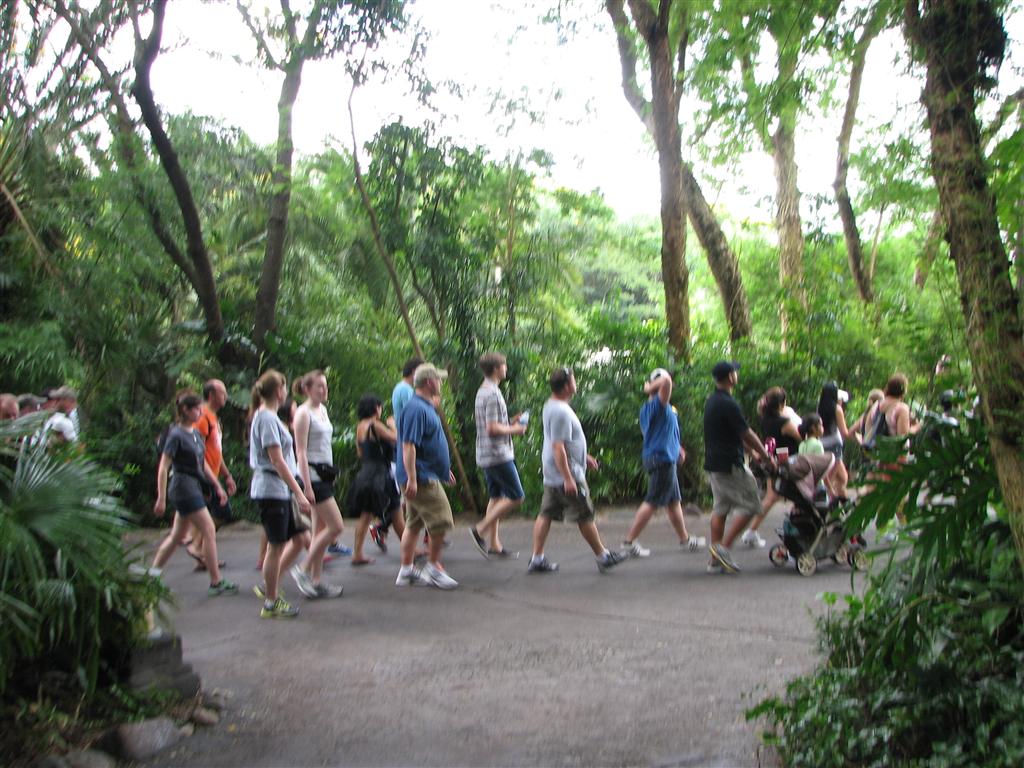 But what about the role of zoo designers? Traditionally, most visitor research has been conducted by the institutions themselves. Recently, however, designers are taking a more active role in studying how visitors behave in and respond to zoo exhibits. PGAV Destinations, for example has not only conducted market research on zoo visitors but has also sent its designers into the field to conduct timing and tracking studies on zoo visitors. Fueled with hard data and facts from their studies, designers are making more-informed decisions about exhibit design. Moreover, such studies can inform all stages of design, from early concept work and master planning to the detailed design of specific exhibit elements. Visitor studies allow designers to more-fully understand the impact of various factors on visitor behavior. For example: designers might test the impact of path width on crowd movements and density, or the correlation between the length of a viewing window and length of stay, and so on. Visitor studies also help set realistic expectations about visitor response to new exhibits (dwell time, level of engagement, etc.). In fact, the predictive power of visitor studies is arguably their most useful benefit. Visitor studies can be used not only to test design decisions and to determine the relative success of existing exhibits but also (and perhaps more importantly) to inform the design of future exhibits.
But what about the role of zoo designers? Traditionally, most visitor research has been conducted by the institutions themselves. Recently, however, designers are taking a more active role in studying how visitors behave in and respond to zoo exhibits. PGAV Destinations, for example has not only conducted market research on zoo visitors but has also sent its designers into the field to conduct timing and tracking studies on zoo visitors. Fueled with hard data and facts from their studies, designers are making more-informed decisions about exhibit design. Moreover, such studies can inform all stages of design, from early concept work and master planning to the detailed design of specific exhibit elements. Visitor studies allow designers to more-fully understand the impact of various factors on visitor behavior. For example: designers might test the impact of path width on crowd movements and density, or the correlation between the length of a viewing window and length of stay, and so on. Visitor studies also help set realistic expectations about visitor response to new exhibits (dwell time, level of engagement, etc.). In fact, the predictive power of visitor studies is arguably their most useful benefit. Visitor studies can be used not only to test design decisions and to determine the relative success of existing exhibits but also (and perhaps more importantly) to inform the design of future exhibits.
What Studies Exist?
 Who can we learn from? Historically, museums, science centers and National Parks have conducted detailed visitor studies. In fact, much of the current information regarding visitor behavior is taken from the museum world, where researchers are constantly evaluating the success of their exhibitions. Further afield, researchers should learn not only from the work of traditional research outlets (like educational psychology, sociology, and environmental science) but also from more unexpected disciplines (like marketing and consumer research). As an example: one researcher noted the similarity of zoo visitor studies to his own research on shopping behavior in grocery stores (Yalowitz & Bronnenkant, 2009). Finally, Theme Parks and similar entertainment destinations – with particular strengths in quantifying visitor flow, tracking & timing, and revenue generation – are a vast and relatively untapped resource in the Zoo world.
Who can we learn from? Historically, museums, science centers and National Parks have conducted detailed visitor studies. In fact, much of the current information regarding visitor behavior is taken from the museum world, where researchers are constantly evaluating the success of their exhibitions. Further afield, researchers should learn not only from the work of traditional research outlets (like educational psychology, sociology, and environmental science) but also from more unexpected disciplines (like marketing and consumer research). As an example: one researcher noted the similarity of zoo visitor studies to his own research on shopping behavior in grocery stores (Yalowitz & Bronnenkant, 2009). Finally, Theme Parks and similar entertainment destinations – with particular strengths in quantifying visitor flow, tracking & timing, and revenue generation – are a vast and relatively untapped resource in the Zoo world.
In the past couple of decades, Zoos have started conducting their own visitor studies. Organizations have begun compiling resources and developing literature reviews, like Visitor Learning in Zoos and Aquariums: A Literature Review (Dierking, Lynn, et al, 2001-2002). Of particular note is a recent, comprehensive, multi-institutional and cross-discipline effort by the EAZA to compile a list of relevant visitor studies: Looking at People Looking at Animals: An International Bibliography on Visitor Experience Studies and Exhibit Evaluation in Zoos and Aquariums (EAZA Education Committee, 2011). A particular strength of current studies is the focus on interpretation, education, and the impact of conservation messaging on zoo visitors.
What Studies Should Be Conducted?
Because of their unique position in the Zoo world, groups like the AZA and EAZA should be conducting visitor studies that play to their strengths as broad, multi-institutional organizations. Such groups should conduct more comprehensive, nationwide or international surveys that bridge the gaps between separate Zoos. These should include literature reviews, bibliographies, and cross-institutional visitor studies. Such studies would be particularly useful for comparing the relative success of exhibits at different institutions and for identifying key trends across several Zoos. They may also serve to establish methodological standards and to encourage Zoos to conduct more detailed studies of their own institutions.
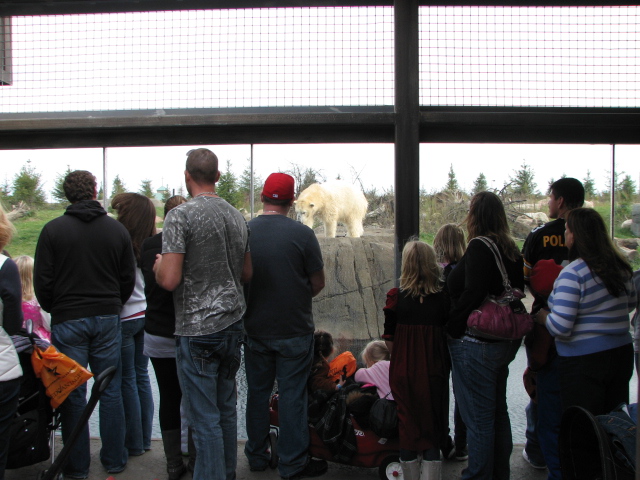 Zoos, meanwhile, should be harvesting a wealth of information about their visitors, with a particular focus on the unique circumstances at their specific institution. It is important for Zoos to understand what makes their zoo different from others – variables ranging from the demographic make-up of its visitors and its region to the institution’s focus, goals, strengths and challenges. What works at one Zoo (e.g. a new polar bear exhibit that draws new visitors by the thousands) does not always work at another. Uniquely positioned to study their visitors, Zoos should use all the resources at their disposal – from the ability to track operational data like hourly attendance and revenue to the dozens of staff and volunteers eager to help.
Zoos, meanwhile, should be harvesting a wealth of information about their visitors, with a particular focus on the unique circumstances at their specific institution. It is important for Zoos to understand what makes their zoo different from others – variables ranging from the demographic make-up of its visitors and its region to the institution’s focus, goals, strengths and challenges. What works at one Zoo (e.g. a new polar bear exhibit that draws new visitors by the thousands) does not always work at another. Uniquely positioned to study their visitors, Zoos should use all the resources at their disposal – from the ability to track operational data like hourly attendance and revenue to the dozens of staff and volunteers eager to help.
But Zoos and their umbrella organizations are not the only groups who should study zoo visitors. Zoo designers should be conducting visitor studies as well. Such studies should be targeted and detailed, focusing on a specific factor, variable or design criteria the zoo designers wish to better understand through data and facts. For example, Zoo designers may wish to study the impact of exhibit temperature (say, at indoor cold-weather penguin exhibits) on dwell time, level of engagement, and walking speed. Or they may study the impact of the size of an underwater viewing window on the length of stay and the number of viewers the window can reasonably accommodate at any given time. Likewise for other factors like water clarity, animal activity, path width, type of interpretive elements, level of cultural theming, and the like. Studying the impact of specific design variables should inform future design decisions and lead to better understanding of what makes an exhibit successful. Tracking and timing studies – those that focus on factors like dwell time, crowd flow, level of engagement, etc. – are particularly useful for designers. But few zoo designers are currently studying visitors. Those that are have a distinct advantage over their counterparts.
 Issues
Issues
Despite the recent insurgence of zoo visitor studies, the field is plagued by a number of issues. Studies are done sporadically by separate institutions, which are sometimes reluctant to share their results. Those that are published are often difficult to compare, due to inconsistent criteria, small sample sizes, and idiosyncratic results (usually resulting from poor study design). This is particularly problematic when trying to evaluate the relative success of different exhibits at different institutions. Fortunately, several researchers have made recommendations regarding methodology and indicators for comparison – including dwell time and the Sweep Rate Index (SRI), which standardizes for different exhibit sizes (Yalowitz & Bronnenkant, 2009).
A bigger issue may be that most of the current research is focused on visitor education, to the neglect of other, important areas. Though a lofty goal, Zoo visitor research should focus on more than just conservation messaging. Besides asking what their visitors are learning, Zoos should also ask questions like: “How can we improve the visitor experience beyond communicating our message? How well are we entertaining as well as educating? Are we generating sufficient revenue to meet our future goals?” Revenue generation, though perhaps less esteemed than interpretation and messaging, is absolutely essential for the Zoo to meet its other goals. Detailed visitor studies can inform everything, from dining menus and the location of food carts or retail (e.g. was that gift shop at the end of the exhibit useful?), to opportunities for high-end experiences, like tours and one-on-one interactive experiences with animals. And most importantly, Zoos should be asking “What’s next?” and looking to the future, of not just their institution but of zoo design itself.
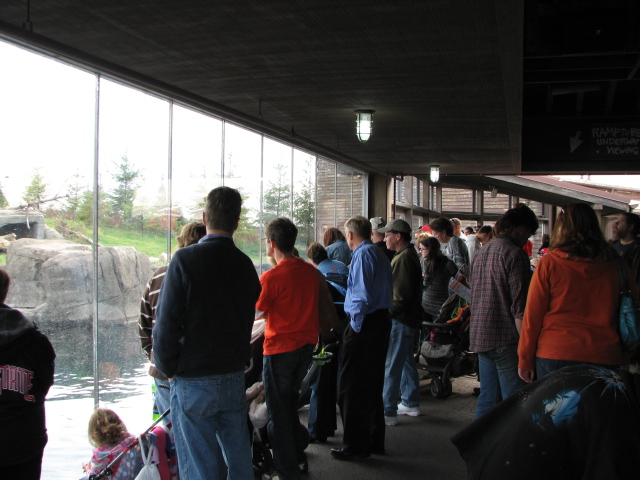 Trends and the Future of Visitor Studies
Trends and the Future of Visitor Studies
Researchers of visitor behavior should look to the future for new ideas, including new methods of collecting and analyzing data. Technology is increasingly being used as a tool for understanding visitor behavior. Researchers can now use videotaping, hand-held digital devices or software systems for recording and analyzing data (including the Noldus Observer and the Museum Experience Recorder system). Taking this a step further, the Walt Disney Company has reportedly invested more than $1 billion on its so-called “Next Generation Experience” project, a technology and marketing initiative focused on detailed visitor tracking and data-mining. Soon, all visitors to Walt Disney World will wear RFID bracelets throughout the resort, allowing the company to collect detailed data on individual spending habits, crowd movements and more – a literal “marketing bonanza” (Garcia, 2013). What’s next? Eye-tracking software to analyze visitor interest (Ross & Wagner, 2012), or personalized itineraries that visitors can create on digital mobile devices? The possibilities are endless.
Ultimately, designers should take a much greater role in conducting visitor studies. Designers may think they know what constitutes good zoo design, but they should confirm their assumptions and back them up with data and facts. The best way to do this is to conduct detailed studies of zoo visitors and factors that impact their designs. There is enormous potential to benefit from the wealth of information out there, just waiting to be collected, analyzed and understood. Designers should take the lead in studying the visitors that come to their Zoos.
Bibliography
Association of Zoos & Aquariums. "Why Zoos & Aquariums Matter: Assessing the Impact of a Visit to a Zoo or Aquarium." 2007. Association of Zoos & Aquariums. Web. 27 December 2012. <http://www.aza.org/uploadedFiles/Education/why_zoos_matter.pdf>.
Dierking, Lynn, et al. "Visitor Learning in Zoos and Aquariums: A Literature Review." 2001-2002. International Zoo Educators Association. Web. 27 December 2012. <http://www.izea.net/education/AZA-Visitor_Leaning_in_Zoos_Aquraiums_Literature_Review.pdf>.
EAZA Education Committee. "Looking at People Looking at Animals: An International Bibliography on Visitor Experience Studies and Exhibit Evaluation in Zoos and Aquariums." February 2011. European Association of Zoos and Aquaria. Web. 27 December 2012. <http://www.eaza.net/activities/education/Documents/2011-02-10%20Visitor%20Studies%20Bibliography%20%20V0.3.pdf>.
Francis, David, Maggie Esson and Andrew Moss. "Following Visitors and What It Tells Us: The Use of Visitor Tracking to Evaluate ‘Spirit of the Jaguar’ at Chester Zoo." 2007. International Zoo Educators Association. Web. 27 December 2012. <http://www.izea.net/education/journal%202007%20following%20visitors%20and%20what%20it%20tells%20us.pdf>.
Garcia, Jason. "Orlando Sentinel." 2013 7 January. Disney reveals NextGen details with 'MyMagic+'. Web. 7 January 2013. <http://www.orlandosentinel.com/the-daily-disney/os-disney-reveals-next-gen-details-20130107,0,6117836.story>.
Ridgway, Stephanie Clark, Margaret Livingston and Steven E. Smith. "Visitor Behavior In Zoo Exhibits With Underwater Viewing." Visitor Studies Today 2005: 1, 3-10. Web. 27 December 2012. <http://ag.arizona.edu/research/azalfalf/pdf_pubs/zoo_visitor_behavior.pdf>.
Ross, Steve and Kathleen Wagner. "Visitor Behavior in Zoos and Aquariums." Connect: Association of Zoos & Aquariums May 2012: 42-43. Print.
Yalowitz, Steven S. and Kerry Bronnenkant. "Timing and Tracking: Unlocking Visitor Behavior." Visitor Studies 12.1 (2009): 47-64. Web. 2012 27 December. <http://www.tandfonline.com/doi/pdf/10.1080/10645570902769134>.
Eileen Ostermeier studied architecture at Washington University in St. Louis and later received her Masters in Landscape Architecture from The Ohio State University, where she focused on habitat design and restoration. She has been with PGAV for 4 years and is currently working on Safari Africa! at the Columbus Zoo. eileen.ostermeier@pgav.com
Study Shows Captive Dolphins Benefit from Interaction Programs & Shows
The perceived high level of intelligence in dolphins often makes them the center of controversy, especially in relation to captivity. Recently, the activism spotlight has focused on the horrific practices in Japanese fishing town, Taiji, where pods of cetaceans, including pilot whales and bottlenose dolphins, are driven into a 'killing lagoon' for slaughter or collection by marine life facilities. This purported 'tradition' was featured in an Oscar winning documentary (which I haven't brought myself to watch--not enough Kleenex in this world...) several years ago called The Cove, and continues to make headlines (especially on social media like Twitter) as awareness increases.
 The secondary goal of the Taiji hunts--collecting specimens for dolphinariums and theme parks--often brings the issue of captivity, in general, under scrutiny. While I personally do not condone the taking of any animals from the wild--except in extreme cases where the animal will otherwise perish--and I believe the practice to be quickly dying away, many equate all captive facilities with the Taiji methods. Many activists make the wild leap from speaking out against Taiji to boycotting responsible facilities such as SeaWorld (who, I should note, does a lot of good for wild animals through solid and widespread rescue and rehab efforts). In doing so, captive collections are unjustly brought under fire--and with dolphins specifically, the issue of interaction programs (such as swim-withs and touches) and shows are often cited as deplorable.
The secondary goal of the Taiji hunts--collecting specimens for dolphinariums and theme parks--often brings the issue of captivity, in general, under scrutiny. While I personally do not condone the taking of any animals from the wild--except in extreme cases where the animal will otherwise perish--and I believe the practice to be quickly dying away, many equate all captive facilities with the Taiji methods. Many activists make the wild leap from speaking out against Taiji to boycotting responsible facilities such as SeaWorld (who, I should note, does a lot of good for wild animals through solid and widespread rescue and rehab efforts). In doing so, captive collections are unjustly brought under fire--and with dolphins specifically, the issue of interaction programs (such as swim-withs and touches) and shows are often cited as deplorable.
I am here to set the record straight.
A recent study published in Animal Welfare examined the effects of shows and interaction programs on 18 Atlantic bottlenose dolphins in six facilities across the U.S. The study clearly indicated that these programs did not produce deleterious effects on the dolphins; in fact, the study found an increase in positive behaviors indicating interaction programs and shows are actually beneficial to captive dolphins. "The increases in behavioural diversity, variation in swimming style, activity levels and play behaviour following both types of programmes are likely a result of the complexity, unpredictability and choices afforded to the animals during these programmes." In other words, much like the findings in a similar study on giraffe feeding, these programs are enrichment opportunities for the dolphins.
 Please note that the participating institutions are all accredited by the AZA, IMATA, and / or Alliance of Marine Mammal Parks & Aquariums--an important distinction indicating these facilities abide by the strictest of standards for responsible husbandry of the animals in their care. If you'd like to boycott facilities, I suggest you boycott those who do not meet these standards or refuse to comply.
Please note that the participating institutions are all accredited by the AZA, IMATA, and / or Alliance of Marine Mammal Parks & Aquariums--an important distinction indicating these facilities abide by the strictest of standards for responsible husbandry of the animals in their care. If you'd like to boycott facilities, I suggest you boycott those who do not meet these standards or refuse to comply.
If you'd like to read the study, please use the links above to request a copy from the publisher.
November Animal of the Month: Chimps
 Ah, those gregarious primates who remind us what it means to be human. They're the perfect capstone species to the year. (No December AotM) Did you know chimps breed throughout the year--whenever the urge strikes? Did you know they are altruist and have been seen grooming and cradling rocks? Find out more--including how large to design a day room and which exhibits to benchmark--by checking out the latest edition of the Animal of the Month fact sheet.
Contact me to receive this and all upcoming fact sheets directly and automatically.
Ah, those gregarious primates who remind us what it means to be human. They're the perfect capstone species to the year. (No December AotM) Did you know chimps breed throughout the year--whenever the urge strikes? Did you know they are altruist and have been seen grooming and cradling rocks? Find out more--including how large to design a day room and which exhibits to benchmark--by checking out the latest edition of the Animal of the Month fact sheet.
Contact me to receive this and all upcoming fact sheets directly and automatically.
October Animal of the Month: Flamingo
 Why does a flamingo stand on one leg? Because if he lifted both, he'd fall over! This is not included in the October Animal of the Month fact sheet about the many species of flamingo, but a lot of other great information is. Like, how flamingos build their nests, and how deep to build your next flamingo pool.
Why does a flamingo stand on one leg? Because if he lifted both, he'd fall over! This is not included in the October Animal of the Month fact sheet about the many species of flamingo, but a lot of other great information is. Like, how flamingos build their nests, and how deep to build your next flamingo pool.
If you'd like to receive this and all of the upcoming Animal of the Month fact sheets, contact me directly. I'll get you signed up to receive them.
Historic Buildings: Obstacles or Opportunities?
By Russell Ploutz Historic zoo buildings are a growing dilemma for zoos, especially older zoos. The historic buildings don’t meet current design standards for animals, but laws require preserve of culturally significant structures. Are these buildings limiting the potential of zoos or seeds for innovation?
The subject of preservation of historic buildings has been on my mind lately after talking with a student researching education at the Buenos Aires Zoo. Many of the zoo’s design challenges are complicated by the numerous historical structures, monuments and paths designated for preservation in the 124 year old zoo. In thinking about the challenges the historical buildings present the zoo, I considered the historic buildings as an opportunity instead of a problem.
The first thought I had was a general design strategy that inverts the current spaces for animals and visitors. The concept designates the buildings and areas for preservation into spaces for visitors while the current people spaces are redesigned for animals. The existing visitor area is freed for animals and exhibits with space for animal enclosures and new support buildings. Since the buildings are easier to renovate for visitor uses than animals, the design strategy may be a more feasible solution than renovating the buildings for new animal standards.
By using the inversion design strategy, the buildings are integrated into the new exhibit environment. As visitors move through the exhibits, the buildings could be used for viewing windows into the exhibits. The buildings could also tell cultural stories and stimulate visitor’s recall of prior knowledge. Additionally, the interior space could be used for large educational exhibits and interpretives.
Reusing historic buildings is not a new concept for zoos. At the Toledo Zoo, the original feline house was reused as a new restaurant. In St. Louis, the zoo converted the historic elephant house into new exhibition space. In addition to adapting spaces for people, the Kansas City Zoo converted a historic building originally used for large mammals to a building for smaller rainforest animals.
Zoos should not feel required to preserve historic buildings due to government requirements, but zoos should want to share their history. Even though the buildings and landscapes may represent memories zoos want to forget, they are a part of their history and our cultural attitudes toward animals. Zoos could use the buildings to tell stories about improving conservation efforts and society’s evolving attitudes toward wildlife.
Not only do structures need new life, but what about the landscapes? How can they be reimagined to contribute to zoo’s conservation efforts? After all, zoos are primarily outdoor environments.
With some innovative thinking historic buildings can gain new life. Ultimately, if the building meets the needs of animals and visitors learn from the experience, is it not a successful exhibit?
Entertaining the Future, Part 1 (AZA, 2012)
One of the most interesting sessions I attended this year was lead by PGAV’s own fantastically enthusiastic designer, Dave Cooperstein. His specialty within our office is show production, which, you may think, is traditionally confined within the theme park arena. However, Dave’s point is every show--no matter how  small (think: keeper chat)--can tell a powerful story. It just takes a little planning.
Storytelling, as we’ve talked about before on Designing Zoos, is a powerful tool to reach your guests emotionally, on a personal level, and to convey a conservation message. Storytelling, and thus personal connection, is at the heart of great show production.
small (think: keeper chat)--can tell a powerful story. It just takes a little planning.
Storytelling, as we’ve talked about before on Designing Zoos, is a powerful tool to reach your guests emotionally, on a personal level, and to convey a conservation message. Storytelling, and thus personal connection, is at the heart of great show production.
Dave suggests that smaller ‘shows’ like keeper chats are excellent ways to connect on a personal level, and can be great theater. But these connections can be created on any  level, from a one-on-one interaction to a mega, arena show.
level, from a one-on-one interaction to a mega, arena show.
The critical element is to understand that varying audience sizes should be a strategy within your educational master plan, as each size and scope may more effectively convey a specific message. Beyond that, providing a variety of show experiences keeps families of all ages and sizes entertained throughout the day which increases satisfaction and encourages repeat visits.
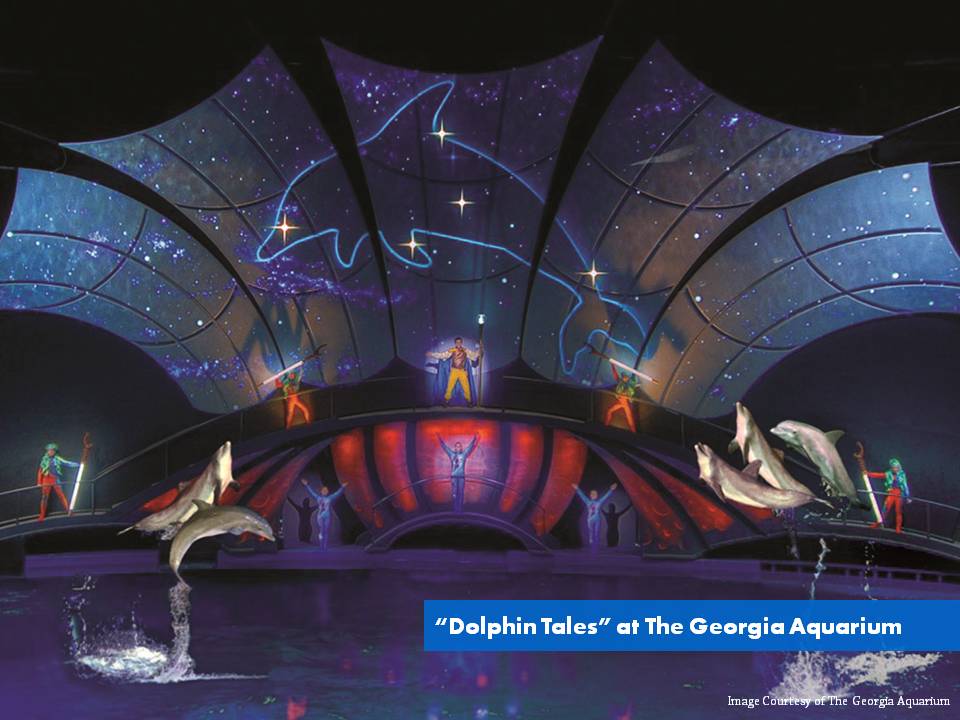 So how can you effectively plan shows for your institution? Dave suggests a logical approach of goal setting and programming based on a defined set of show production criteria, such as:
So how can you effectively plan shows for your institution? Dave suggests a logical approach of goal setting and programming based on a defined set of show production criteria, such as:
- Theater size
- Concessions
- Performer type
- Music
- Story conveyance
 Thorough evaluation of each of these characteristics looks not at the quality level, but at the specific assessment of size, scope, technology needs, staff allocation, etc. These evaluations will indicate where along the Show Production Scale your shows may fall—with the intention of creating a variety of experiences throughout your park.
Thorough evaluation of each of these characteristics looks not at the quality level, but at the specific assessment of size, scope, technology needs, staff allocation, etc. These evaluations will indicate where along the Show Production Scale your shows may fall—with the intention of creating a variety of experiences throughout your park.
Stay tuned for Part II where Dave explores the past, present and future of show production.
Training Butterflies for Interactions
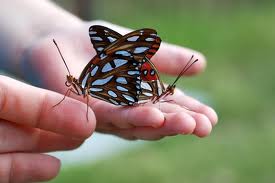 During the AZA 2012 poster session, I came across an intriguing group describing how they've successfully trained butterflies for interactions. Yes, you read that correctly. In actuality, "training" is somewhat a misnomer for butterflies; more accurately, they are habituated for handling, and manipulated into long basking periods (by understanding the natural physiology and behavior of the insects).
Woodman, Kim and Kassinger have seen the benefits of these increased and prolonged interactions through guest enjoyment, but also by leveraging the experience for revenue potential: the consistency of behavior allows for guaranteed photo ops.
During the AZA 2012 poster session, I came across an intriguing group describing how they've successfully trained butterflies for interactions. Yes, you read that correctly. In actuality, "training" is somewhat a misnomer for butterflies; more accurately, they are habituated for handling, and manipulated into long basking periods (by understanding the natural physiology and behavior of the insects).
Woodman, Kim and Kassinger have seen the benefits of these increased and prolonged interactions through guest enjoyment, but also by leveraging the experience for revenue potential: the consistency of behavior allows for guaranteed photo ops.
Learn more about their project and how you can create your own program by reading their full paper here: Butterfly Experiences by Woodman, Kim & Kassinger
Learning in Zoos: Design Guidelines, Part 3
By Russell Ploutz Example projects
To understand how to apply the nine principles and fifty-three guidelines, I designed seven example projects. The projects illustrate how the design guidelines coalesce to create a cognitive experience and shape the exhibit form. For each of the example projects, illustrations and narratives explain how the exhibit engages and facilitates visitor’s learning processes following the design guidelines. Projects like Who is Right?, Help the Otters, and Two Waterways describe exhibit concepts and possible design strategies for using the guidelines such as comparison, decision-making and action-taking.
One example project, Four Lives, centers on the activity of role playing and decision-making. First, visitors choose to be a farmer, poacher or ranger and throughout the exhibit experience situations and information specific to their character. In some situations they make decisions applying their prior knowledge, information presented in the exhibit and their emotions by reacting to the situation affecting their character. The exhibit facilitates the decision-making process by stimulating recall with design elements, guiding understanding with trained actors and engaging advanced cognitive processes. To enable their application of knowledge, the visitor circulation is a network of pathways where at each junction visitors choose a path linked to their decision. The chosen path leads visitors to a new situation embodying the consequence of their decision, providing feedback on their application of learning.
Design Manual
I compiled the example projects, guidelines and background information into an interactive digital document. The interactivity reflects the complexity and interconnected process of learning by providing hyperlinks to related information using a navigation bar. The bar helps the reader navigate the complexity and make connections between related concepts, guidelines and example projects.
Overall, the design manual presents a vision of increased visitor engagement and greater influence of exhibits on learning. It demonstrates how the program, exhibit organization and spatial characteristics can affect visitor’s learning processes. Additionally, the document raises questions about the design approach and extra design processes needed in the design of zoo exhibits for learning. Ultimately, the guidelines have the potential to provide new visitor experiences and design strategies which engage learning processes, helping to achieve zoo’s goal of conservation.
If you are interested in the other example projects, learning more about cognitive processes, and how exhibits can facilitate learning feel free to contact me at russell.ploutz@gmail.com.
Learning in Zoos: Design Guidelines, Part 2
By Russell Ploutz After recalling prior knowledge and preparing visitors for learning, the exhibit and included activities can facilitate learning processes by employing the following principles to improve understanding.
5. Grasp - capitalize on concrete experiences.
The Grasp principle describes how exhibits can most effectively leverage the unique experiences people come to zoos for - personal experiences with animals and nature. Exhibits can use concrete experience to help visitors understand abstract concepts such as ecological processes, critical to understanding zoo’s messages. The principle describes how to coordinate the presentation of abstract concepts with concrete experiences and vice versa.
6. Guide - facilitate meaning-making.
Exhibits can also assist visitors in understanding new information by guiding them in the meaning-making process. The Guide principle describes how exhibits can facilitate understanding with visitor activities and exhibit situations by stimulating additional cognitive processes.
7. Apply - reinforce learning with application.
After understanding new information, exhibits can encourage visitors to use their new knowledge to reinforce the learning. By applying information in new situations visitor’s understanding strengthens with increased contextualization. The Apply principle describes design strategies for visitor activities and exhibit situations promoting application of learning.
8. Transfer – connect information to other situations.
Similarly, the Transfer principle explains how learning is a continual process where people use information from previous experiences and in future ones - the learning experience is but one point in time. This principle explains how exhibits can embrace the dynamic process of learning by making connections to other situations outside of the immediate exhibit context.
9. Individual - facilitate different learning preferences.
The Individual principle describes how the learning process is unique to different visitors. We each have personal preferences for learning and since we control what we engage in zoos, exhibits need to reach the largest audience possible by appeal to many different types of visitors. The principle explains how to employ our choice and control to increase understanding by designing for each of Gardner’s Multiple Intelligences.
Part 3 in Russell Ploutz's series...
Learning at Zoos: Design Guidelines, Part 1
We at DesigningZoos.com always love guest bloggers and new, insightful information. So when former PGAV intern, Russell Ploutz, offered to share his thesis project on learning in zoos, I jumped at the chance to share his brilliance with the world. He has summarized his extremely in-depth and thoughtful project for us, and I'll be posting it via 3 installments. Without further adieu... Cognitive Based Zoo Design Guidelines by Russell Ploutz
What is learning?
Learning is the process of transforming information into knowledge using cognitive processes - the “mental process that individuals undergo as they think, learn, and perform problem-solving and decision-making activities.” If humans use predictable processes during learning, how can zoo exhibits engage those processes to improve visitor learning? Insights from cognitive psychology provide guidance for how to facilitate human learning processes, creating fulfilling visitor experiences while achieving zoos’ mission of education.
By researching the fundamentals of learning I developed a set of design guidelines for zoo exhibits which stimulate and facilitate visitor’s learning processes. I created the design guidelines by gathering professional zoo designer’s input, reviewing literature and personal findings resulting in a design manual for engaging cognitive processes. The manual contains three elements: background information synthesizing literature specific to zoo exhibit designers, design guidelines for engaging learning processes and, example projects I designed illustrating the application of the guidelines.
Learning Principles
Fifty-three design guidelines are grouped into nine principles addressing different aspects of learning. Each learning principle contains related guidelines and background information which ground the guidelines in scientific studies. Additionally, the principles contain methods and potential design strategies for employing the design guidelines.
The first principles describe prerequisite cognitive processes to engage prior to transforming information into knowledge. Meeting these initial principles is critical because without their provision learning is unlikely to occur.
1. Identity - learning needs to fulfill our motivations.
For learning to succeed in places like zoos where we control how and what we engage, we need to want to learn. The Identity principle builds on Falk’s work on Visitor Identities describing visitor’s motivations and needs. The principle explains how to fulfill each visitor’s Identity by productively satisfying their social and personal needs with learning opportunities.
2. Attention - we must engage the exhibit.
Once visitors are motivated to engage in learning, then exhibits can assist visitors in focusing on learning content. For learning to occur, we must direct our attention in the exhibit to acquire information. The Attention principle describes how exhibit characteristics can direct visitor’s attention on learning content to engage the information.
3. Inform - we need to know how to engage.
In addition to directing visitor’s attention on learning content, exhibits also need to inform visitors as to how they can engage in learning. If we do not know how to engage the exhibit, how can we learn from the exhibit? The Inform principle explains how exhibits can directly and indirectly notify visitors of learning opportunities.
4. Recall - we use prior knowledge with new information.
Once visitors are prepared to learn the exhibit can facilitate one of the most critical aspects in learning, the recall of prior information and experiences. We use our past experiences to understand new information and situations through contextualization. This principle explains how exhibit elements and design characteristics can evoke past memories helping visitors understand new information.
AZA 2012 Day 5: Small Zoos, Big Conservation Impacts
My last day at the conference. I'll admit I was up too late sharing cocktails with colleagues the night before, and the intensity of the conference was starting to catch up with me. But I persisted--and managed to squeeze in one last session before running to the airport and to sweet, sweet sleep. The session was a humdinger--indirectly addressing the ever-present question: Why do zoos matter?
 Small zoos (in terms of operating budget) face bigger challenges than their larger sisters. Smaller budgets, more intense competition, smaller markets, less respect and higher scrutiny. But in the face of these challenges, many small zoos still include conservation programs as their highest priorities. In fact, some might say, due to these challenges--lack of respect and increased scrutiny, to be specific--small zoos MUST prioritize conservation.
Small zoos (in terms of operating budget) face bigger challenges than their larger sisters. Smaller budgets, more intense competition, smaller markets, less respect and higher scrutiny. But in the face of these challenges, many small zoos still include conservation programs as their highest priorities. In fact, some might say, due to these challenges--lack of respect and increased scrutiny, to be specific--small zoos MUST prioritize conservation.
 Gladys Porter Zoo, Brownsville, TX (I had to look it up) is one such institution who's taken conservation programming to the next level, despite their size. For over 20 years, the Zoo has not only supported, but created and run a Kemp's Ridley sea turtle program in Mexico. The zoo employs one staff member full time to run the program, in addition to a second staffer dedicated to all other conservation programs. The Zoo earmarks $650,000 every year for this single program, which over the span of the program, has helped protect over 70,000 nests and 4.5 million hatchlings.
Gladys Porter Zoo, Brownsville, TX (I had to look it up) is one such institution who's taken conservation programming to the next level, despite their size. For over 20 years, the Zoo has not only supported, but created and run a Kemp's Ridley sea turtle program in Mexico. The zoo employs one staff member full time to run the program, in addition to a second staffer dedicated to all other conservation programs. The Zoo earmarks $650,000 every year for this single program, which over the span of the program, has helped protect over 70,000 nests and 4.5 million hatchlings.
Dallas World Aquarium similarly helped found the Amazon Rescue Center, a private-public partnership in Peru, principally focusing on Amazonian Manatee conservation. The Aquarium raises over $400,000 annually to support their work along with several other Central and South American conservation programs. Dr. Luis Sigler, senior conservation biologist, believes conservation programs should be run like businesses in order for them to thrive.
So, how can a small zoo or aquarium be expected to create and fund a great project if they find themselves scraping for pennies as it is? Steve Burns, director of ZooBoise, explained how they managed it. Slowly. Starting with a single conservation parking meter, ZooBoise raised $1500 annually. From there, they added a $0.25 conservation 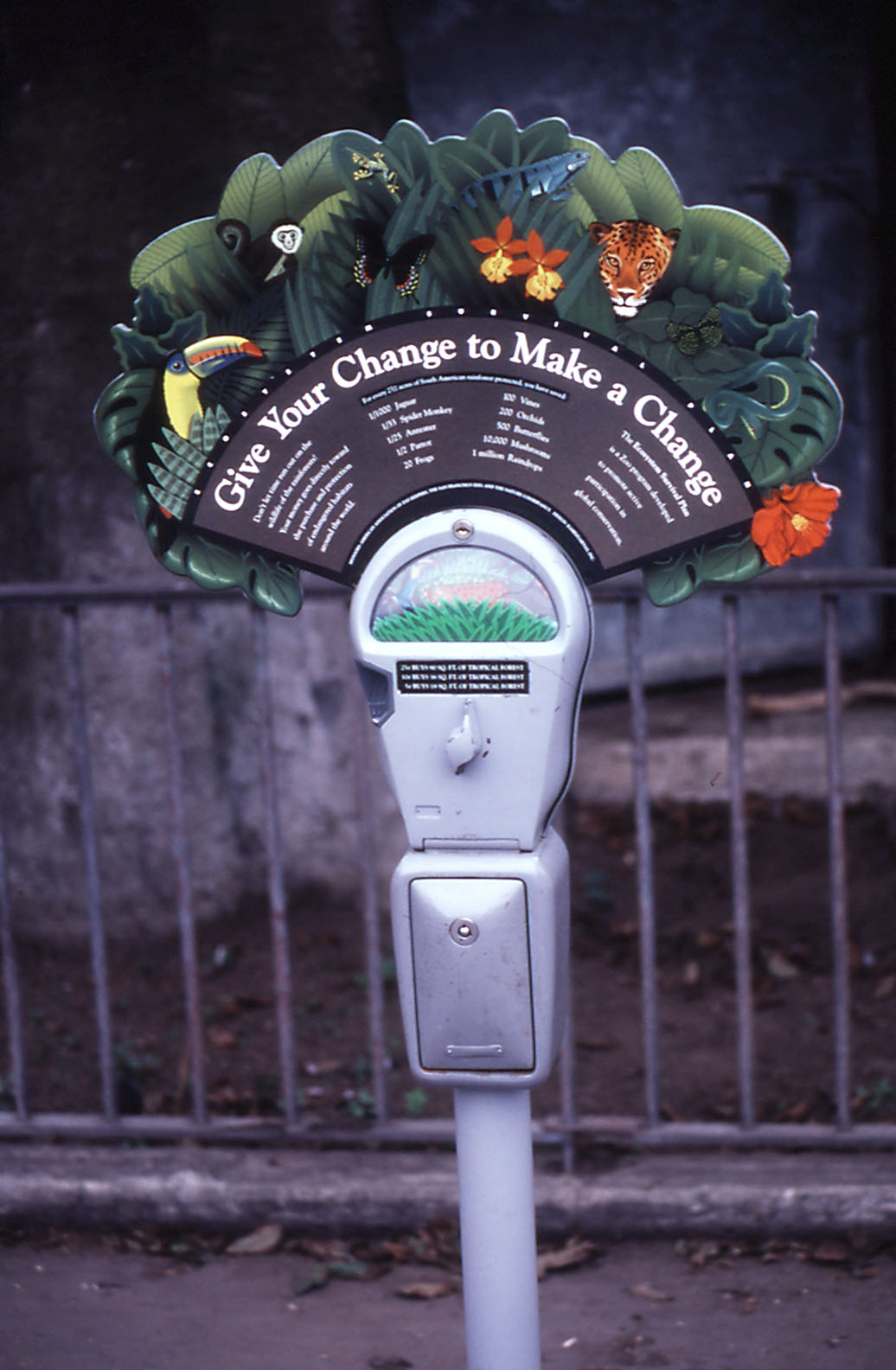 fee onto admission. The fee raised $57,000, and the Zoo recorded two complaints. So they raised it again--by a dime, and increased their conservation collection by $23,000. Now they had the ball rolling. They added a series of fee-based 'special experiences,' including sloth bear feeding, with all of the funds going directly to conservation programs. Currently, they require every new capital campaign to include an additional 10% to go directly to conservation. So that new otter exhibit with a $500,000 price tag now requires $550,000 to be raised. ZooBoise now expects to raise over $200,000 annually for conservation.
fee onto admission. The fee raised $57,000, and the Zoo recorded two complaints. So they raised it again--by a dime, and increased their conservation collection by $23,000. Now they had the ball rolling. They added a series of fee-based 'special experiences,' including sloth bear feeding, with all of the funds going directly to conservation programs. Currently, they require every new capital campaign to include an additional 10% to go directly to conservation. So that new otter exhibit with a $500,000 price tag now requires $550,000 to be raised. ZooBoise now expects to raise over $200,000 annually for conservation.
What does your small zoo or aquarium do for conservation? And how do we let our public know how much good they are doing by supporting zoos? Voice your opinion!
September Animal of the Month: Snow Leopard
 The Snow Leopard generally leads a solitary and snowy life among the rocks of the Himalayan mountains. Learn more about them by signing up to receive the PGAV Destinations Animal of the Month fact sheets by contacting me directly.
Check out a past fact sheet here.
The Snow Leopard generally leads a solitary and snowy life among the rocks of the Himalayan mountains. Learn more about them by signing up to receive the PGAV Destinations Animal of the Month fact sheets by contacting me directly.
Check out a past fact sheet here.
Giraffe Feeding Beneficial to Animals
 Recently, I was engaged in a friendly debate about the merits (or faults) of a giraffe feeding experience. One of the issues that came up was whether or not the experience negatively affected the animals. As it turns out, a student at my alma mater, Michigan State University, was wondering the very same thing.
His research, documented via poster for the AZA Conference Poster Session, indicates giraffe feeding programs act as a form of enrichment for the animals, and are therefore beneficial. His preliminary results follow:
Recently, I was engaged in a friendly debate about the merits (or faults) of a giraffe feeding experience. One of the issues that came up was whether or not the experience negatively affected the animals. As it turns out, a student at my alma mater, Michigan State University, was wondering the very same thing.
His research, documented via poster for the AZA Conference Poster Session, indicates giraffe feeding programs act as a form of enrichment for the animals, and are therefore beneficial. His preliminary results follow:
August Animal of the Month: Manatee
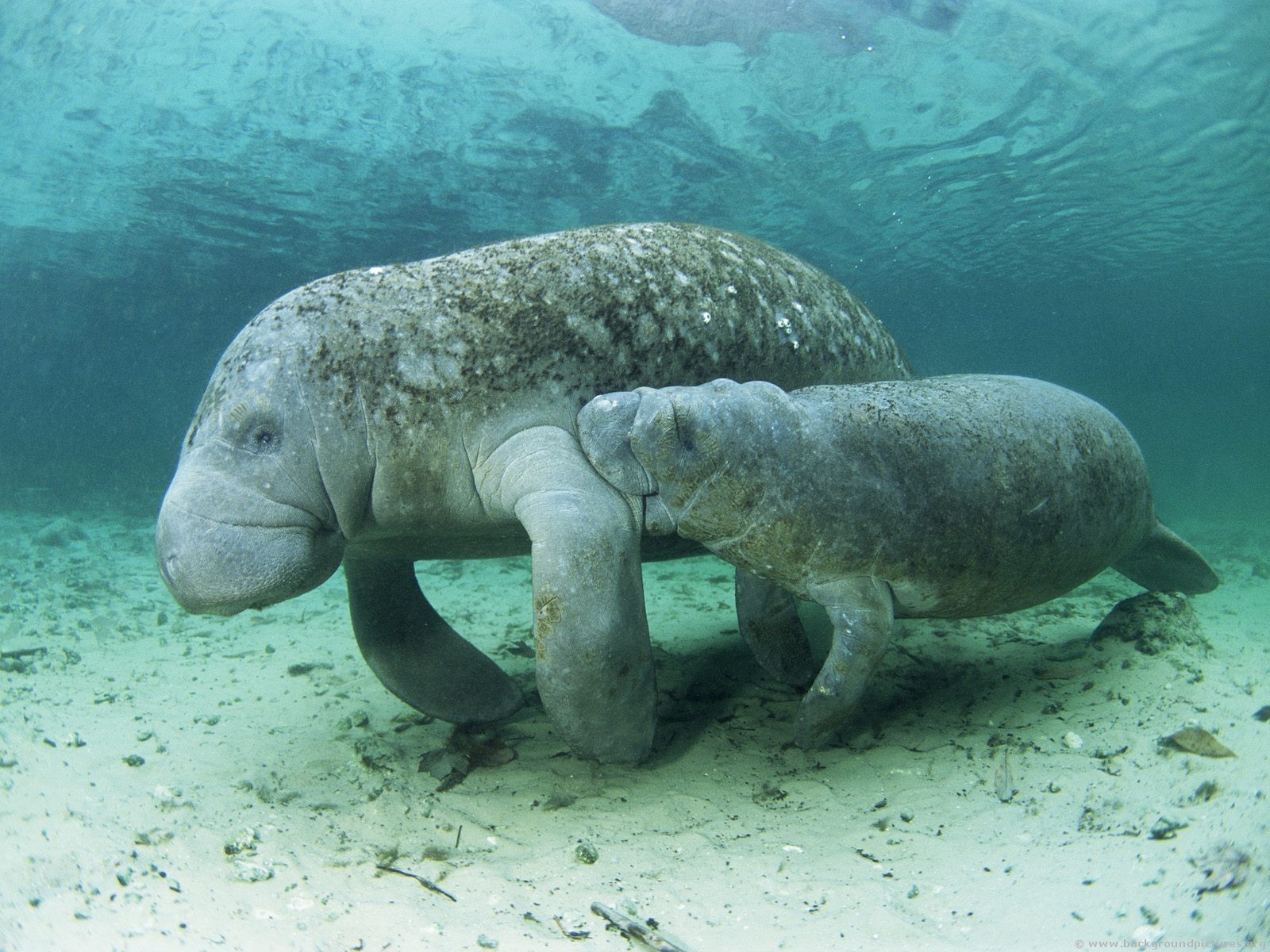 Oh, the lovely sea cow. Once believed to call to sailors, as would a mermaid or, say, a siren, this slow moving, blubbery beauty of the order Sirenia was our focus in August. A favored friend of Florida, the West Indian Manatee is now endangered and relatively rare in captivity. Learn all about this sweet creature here.
Oh, the lovely sea cow. Once believed to call to sailors, as would a mermaid or, say, a siren, this slow moving, blubbery beauty of the order Sirenia was our focus in August. A favored friend of Florida, the West Indian Manatee is now endangered and relatively rare in captivity. Learn all about this sweet creature here.
ATTENTION: This will be the last Animal of the Month that will be posted to the blog. In the future, I will send out the fact sheet via email. If you are interested in receiving them, please contact me.
Case study: Zoo Atlanta
Over on Yes, If..., Jon takes a pretty darn good stab at evaluating Zoo Atlanta's wayfinding and experiential issues. So good, in fact, I've borrowed it for DesigningZoos.com! Check it out here: Case study: Zoo Atlanta.
























